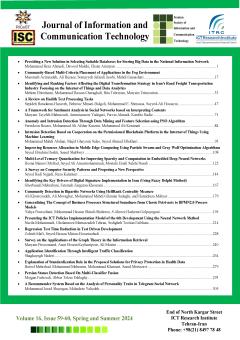A Horizon for Sentiment Analysis in Social Networks based on Interpreting Contents
Subject Areas : AI and Robotics
Maryam Tayefeh Mahmoudi
1
*
,
َAmirmansour Yadegari
2
,
Parvin Ahmadi
3
![]() ,
Kambiz Badie
4
,
Kambiz Badie
4
1 - Data Analysis & Processing Research Group, IT Research Faculty, ICT Research Institute, Iran
2 - ICT Research Institute
3 - Data Analysis & Processing Research Group, IT Research Faculty, ICT Research Institute, Iran
4 - E-Content & E-Services Research Group, IT Research Faculty, ICT Research Institute, Iran
Keywords: Interpreting content, sentiment analysis, social network, content's narrator, rule-type protocol,
Abstract :
Interpreting contents in social networks with the aim of analyzing the sentiment of their narrators is of particular significance. In this paper, we present a framework for such a purpose, which is able to classify the messages hidden in contents based on using some rule-type protocols with high abstraction level. According to this framework, items such as prosodic of a content's narrator, context of disseminating a content and the key propositions in a content's text are regarded in the condition part of a protocol, while the possible classes for the message in a content are considered as its action part. It is to be noted that the proposed rule-type protocols can equally be used for other languages due to the generic-ness of the above-mentioned items. Results of computer simulations on a variety of different contents in the social networks show that the proposed framework is sufficiently capable of analyzing the sentiment of the contents' narrators in these networks.
]1[ رجبی، زینب، محمدرضا ولوی و مریم حورعلی، "مروری بر روش¬های تحلیل احساس در متون فارسی"، فصلنامه پردازش علائم و دادهها، شمارة 2 پیاپی 52، 1401.
]2 [عسگریان، احسان، محسن کاهانی و شهلا شریفی، "حس نگار: شبکه واژگان حسی فارسی"، فصلنامه پردازش علائم و دادهها، شمارة 1 پیاپی 35، 1401.
]3[ علیمردانی، سعیده، عبداله آقایی، "ارائة روش نظارتی برای نظرکاوی در زبان فارسی با استفاده از لغتنامه و الگوریتم "SVM، نشریه مدیریت فناوری اطلاعات دانشکده مدیریت دانشگاه تهران، دوره 7 شماره 2، 1394.
[4] E. Asgarian, M. Kahani and S. Sharifi, "The impact of sentiment features on the sentiment polarity classification in Persian reviews", Cognitive Computation, vol. 10, no.1, pp. 117- 135, 2018.
[5] R. Dehkharghani, "SentiFars: A Persian Polarity Lexicon for Sentiment Analysis", ACM Transactions on Asian and Low Resource Language Information Processing, vol. 19, no. 2, pp. 21, 2019.
]6[ مرادی، مهدی، پروین خسرویزاده، و بهرام وزیرنژاد، "ساخت پیکرههای نشانهگذاریشده با رویکرد وب به عنوان پیکره"، دومین هماندیشی زبانشناسی رایانشی، تهران، 1391.
]7 [نجفزاده، محسن.، سعید راحتی قوچانی و رضا قائمی، "یک چارچوب نیمه نظارتی مبتنی بر لغت نامه وفقی خودساخت جهت تحلیل نظرات فارسی"، فصلنامه پردازش علائم و دادهها، جلد ۱۵ شماره ۲، صفحه 89-102، 1397.
[8] E. Cambria, "An introduction to concept-level sentiment analysis", in Proceedings of Mexican International Conference on Artificial Intelligence, Springer, Berlin, Heidelberg, November 2013, pp. 478-483.
[9] E. Cambria, B. Schuller, Y. Xia, and C. Havasi, "New avenues in opinion mining and sentiment analysis", IEEE Intelligent systems, vol. 28, no.2, pp.15-21. 2013.
[10] N. Ofek, S. Poria, L. Rokach, E. Cambria, A. Hussain, and A. Shabtai, "Unsupervised commonsense knowledge enrichment for domain-specific sentiment analysis", Cognitive Computation, vol. 8, no. 3, pp. 467-477, 2016.
[11] Z. Rajabi, M. Valavi, and M. Hourali, "A model for enriching sentiment lexicon based on semantic knowledge base", in Proceedings of 10th Iranian C4I Conference, Iran, 2017.
]12 [رجبی، زینب، مریم حورعلی و محمدرضا ولوی، "ارائه یک مدل مبتنی بر زمینه برای رفع ابهام از مفاهیم حسی با کمک دانش عرفی"، فصلنامة علمی - پژوهشی فرماندهی و کنترل، سال دوم، شمارة 2، تابستان 1397.
[13] K. P. P. Shein, "Ontology based combined approach for sentiment classification", in Proceedings of the 3rd International Conference on Communications and information technology, December 2009, pp. 112-115.
[14] A. Sureka and D. Correa, "Generating domain-specific ontology from common-sense semantic network for target specific sentiment analysis", in Proceedings of the 5th International Conference of the Global WordNet Association. Mumbai, India, 2010.
[15] E. Kontopoulos, C. Berberidis, T. Dergiades, and N. Bassiliades, "Ontology-based sentiment analysis of twitter posts", Expert systems with applications, vol. 40, no.10, pp. 4065-4074, 2013.
[16] B. Agarwal, N. Mittal, P. Bansal, and S. Garg, "Sentiment analysis using common-sense and context information", Computational Intelligence and Neuroscience, vol. 2015.
[17] B. Agarwal, and N. Mittal, "Sentiment analysis using conceptnet ontology and context information", Prominent Feature Extraction for Sentiment Analysis, Springer, Cham, 2016, pp. 63-75.
[18] F. Amiri, S. Scerri, and M. Khodashahi, "Lexicon-based sentiment analysis for Persian text", In Proceedings of the International Conference on Recent Advances in Natural Language Processing, 2015, September, pp. 9-16.
[19] A. Bagheri, and M. Saraee, "Persian sentiment analyzer: A framework based on a novel feature selection method", International Journal of Artificial Intelligence, vol. 12, no.2, pp. 115-129, 2014.
[20] E. Vaziripour, C. Giraud-Carrier, and D. Zappala,"Analyzing the political sentiment of tweets in Farsi", in Proceedings of the 10th International AAAI Conference on Web and Social Media, March 2016.
[21] S. S. Sadidpour, H. Shirazi, N. M. Sharef, B. Minaei-Bidgoli, and M. E. Sanjaghi, "Context-sensitive opinion mining using polarity patterns", International Journal of Advanced Computer Science and Applications, vol. 7, no. 9, 2016.

